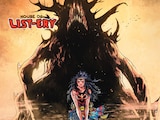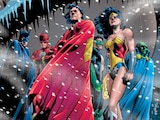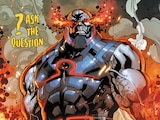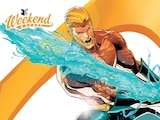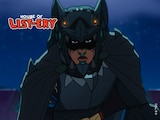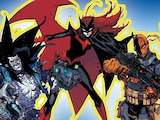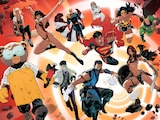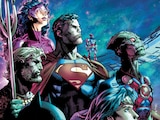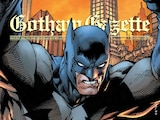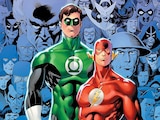Each Friday, we'll be letting a different DC.com writer share what they'll be reading over the weekend and why you might want to check it out. Here's this week's suggestion for a perfect Weekend Escape!
If you’re a DC fan, chances are you have strong opinions about what an ideal Justice League lineup should be. Since the team is more or less the face of the superhero community in the DC Universe, its members play a vital role in determining how superheroes are regarded by the public. For this reason, I always love a slightly dysfunctional Justice League. It grounds the team in more human, everyday problems.
Nowhere does the Justice League shine brighter than in the pages of Justice League International by Keith Giffen, J.M. DeMatteis and Kevin Maguire. For this week’s Weekend Escape, let’s delve into the wonderful world of the late 1980s workplace comedy with Justice League International Vol. 1, spanning issues #1-6 of Justice League (1987) and Justice League International #7.
The Premise:

Justice League International was a new phase for the JL. As their name suggests, they weren’t only serving America’s interests. Instead, they took on a more global presence due to their bases in various embassies around the world. Instead of fighting aliens from space, this Justice League was faced with keeping the peace at the tail end of the Cold War—all with a smart, satirical edge.
Beyond the geopolitics of Justice League International, the team is also defined by their unusual lineup, engagement with contemporary social issues, and tone as a workplace comedy. Originally, the team was composed of Batman, Martian Manhunter, Black Canary (in a brand new, extremely ’80s outfit), Shazam, Blue Beetle, Mister Miracle, Oberon, Doctor Fate, Doctor Light and one troublemaker Green Lantern by the name of Guy Gardner. The team would later expand to include Captain Atom, Rocket Red, Fire, Ice, Big Barda and G’Nort the Green Lantern. This eclectic mix of personalities and egos became the focal point of Justice League International, as the team seemed to always be an argument or two away from disbanding.
Let’s Talk Talent:

Justice League International is a masterclass in creative synergy. Beloved writer Keith Giffen (creator of Jaime Reyes’s Blue Beetle) wrote the plot and breakdowns for the story, while J.M. DeMatteis (Doctor Fate, The Spectre, Adventures of Superman) wrote the dialogue. Giffen and DeMatteis’s collaboration was a stroke of genius on behalf of editor Andy Helfer. At that point in time, DeMatteis was known for writing “deeply profound stories rich in spirituality” (in the words of Giffen), while Giffen was at home with the zanier and self-aware parts of the DC Universe, demonstrated in titles like Ambush Bug. Together, DeMatteis brought a barrage of hilarious one-liners to Giffen’s plots, while also giving each member of the JLI their own distinct voice. Sadly, Keith Giffen passed away last year, so there’s all the more reason to celebrate this landmark work.
Of course, Justice League International would not be what it is without the instantly recognizable art of Kevin Maguire. Maguire’s beautiful linework defined the comedic tone of the series, evident in both his immense talent for drawing expressive faces and in the composition of his panels. Through his art alone, Maguire pulled off visual gags that make JLI worth coming back to time and time again. You truly haven’t lived until you’ve seen the myriad of expressions that Kevin Maguire gives to Guy Gardner.
A Few Reasons to Read:

- Just look at that graphic novel cover (which was reproduced from the original issue #1 art). I love how much personality Maguire gives each character. The ridiculous size of Mister Miracle’s collar, Doctor Fate’s lack of expression through his helmet, Batman’s look of annoyance because he’s squished between Martian Manhunter and Blue Beetle—all of it challenges what we expect to see on the cover of a Justice League book. The fact that they’re all staring at the reader implies that they have a certain level of self-awareness about their importance in the DC Universe. It’s a perfect representation of the guiding principles behind this era of the Justice League.
- This miniseries is the beginning of Blue Beetle and Booster Gold’s friendship! Booster joins the team in issue #3, forever changing the course of Ted Kord’s trajectory as a character. Today, it’s difficult to imagine Ted Kord’s Blue Beetle without Booster Gold. It’s very sweet to take a look back and see their friendship blossom.
- JLI contains one of the funniest panels in comic book history: Batman knocking out Guy Gardner with one punch! Considering how quickly Guy Gardner will get on your nerves, it’s a wonderfully cathartic moment.

- This book also serves as an introduction to one of the greatest romances in comics: Mister Miracle and Big Barda. When Mister Miracle mentions that he has a wife, Batman tells him that it’s dangerous to have a wife as a superhero, presuming that Mister Miracle’s wife isn’t a seven-foot-tall warrior raised by the deadliest people in the universe. Mister Miracle cuts Batman off, saying that his wife “could probably take out the Joker with one hand.” We love a power couple.
- Part of the appeal of JLI is that it gave lesser-known characters the opportunity to shine. Everyone loves Superman, Wonder Woman, the Flash and Green Arrow, but it’s incredibly rare that characters like Mister Miracle, Doctor Fate, Doctor Light and Blue Beetle get their due. By having such a unique lineup, JLI unpacks the role that the Justice League plays in the DCU with regards to international diplomacy. There aren’t very many stories like it.
- The Justice League flies around in Blue Beetle’s Bug vehicle. I know I’m talking a lot about Blue Beetle here. But JLI made me love everything about Ted Kord—so much so that I teared up a little when Jaime Reyes’ family took control of the Bug in this year’s Blue Beetle movie. The Bug is the silliest looking ship in fiction, and the fact that it’s the Justice League’s de facto vessel tells you everything you need to know about this series.
Why It’s Worth Your Time:

Reading JLI isn’t like reading most superhero comics. Instead, it’s more like watching a workplace comedy such as Abbott Elementary or Parks and Recreation. You don’t need to worry about things like canon or whether you truly understand nebulous concepts like the Speed Force or the omniverse. In that sense, it’s very refreshing to just open a book and experience pure joy right from the first page. It’s also a perfect gateway into other areas of the DC Universe, like the New Gods, if you feel inspired to delve deeper.
This is my go-to series whenever I am feeling sad. No matter how many times I’ve read it, it always makes me laugh, and I hope it can do the same for you. The collaboration between Giffen, DeMatteis and Maguire is simply comics at their best.
Justice League International Vol. 1 by Keith Giffen, J.M. DeMatteis, Kevin Maguire and Al Gordon is available in print as a paperback collection or can be read in full on DC UNIVERSE INFINITE.
Jules Chin Greene writes about comics for DC.com, and his work can also be found at Nerdist, Popverse and Multiverse of Color. You can follow him on Twitter and Bluesky at @JulesChinGreene.
NOTE: The views and opinions expressed in this feature are solely those of Jules Chin Greene and do not necessarily reflect those of DC or Warner Bros. Discovery, nor should they be read as confirmation or denial of future DC plans.



